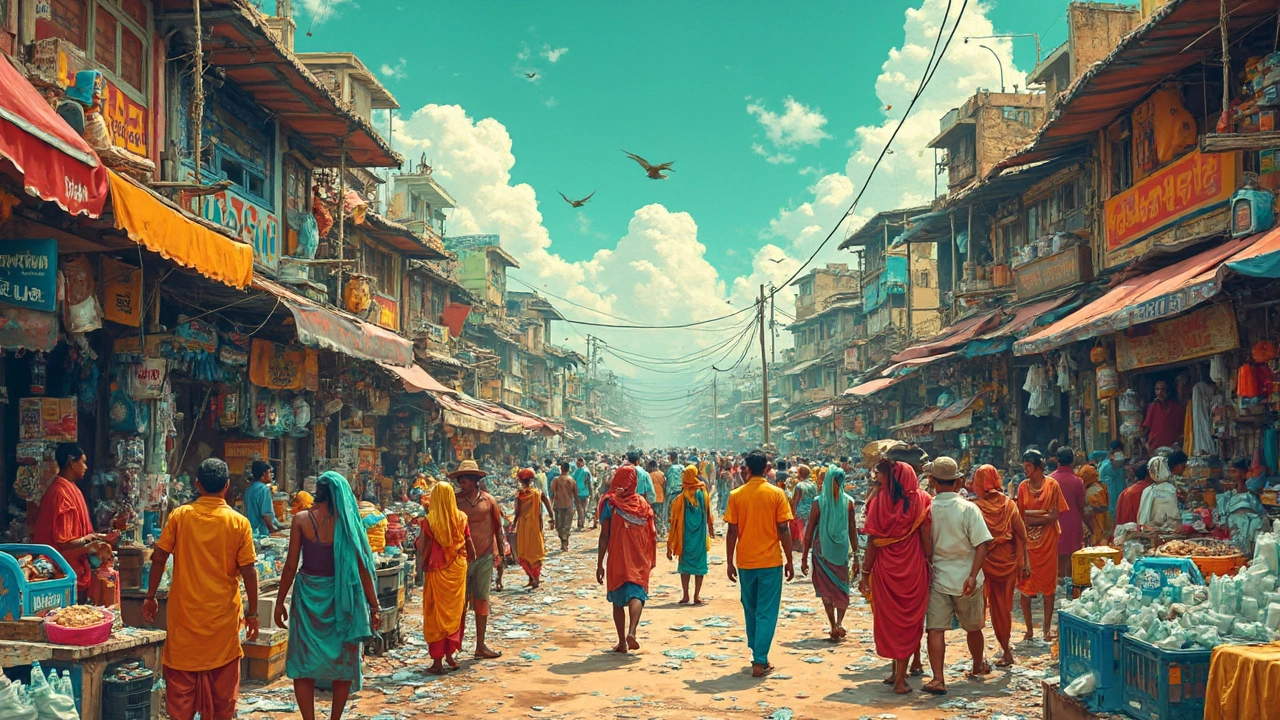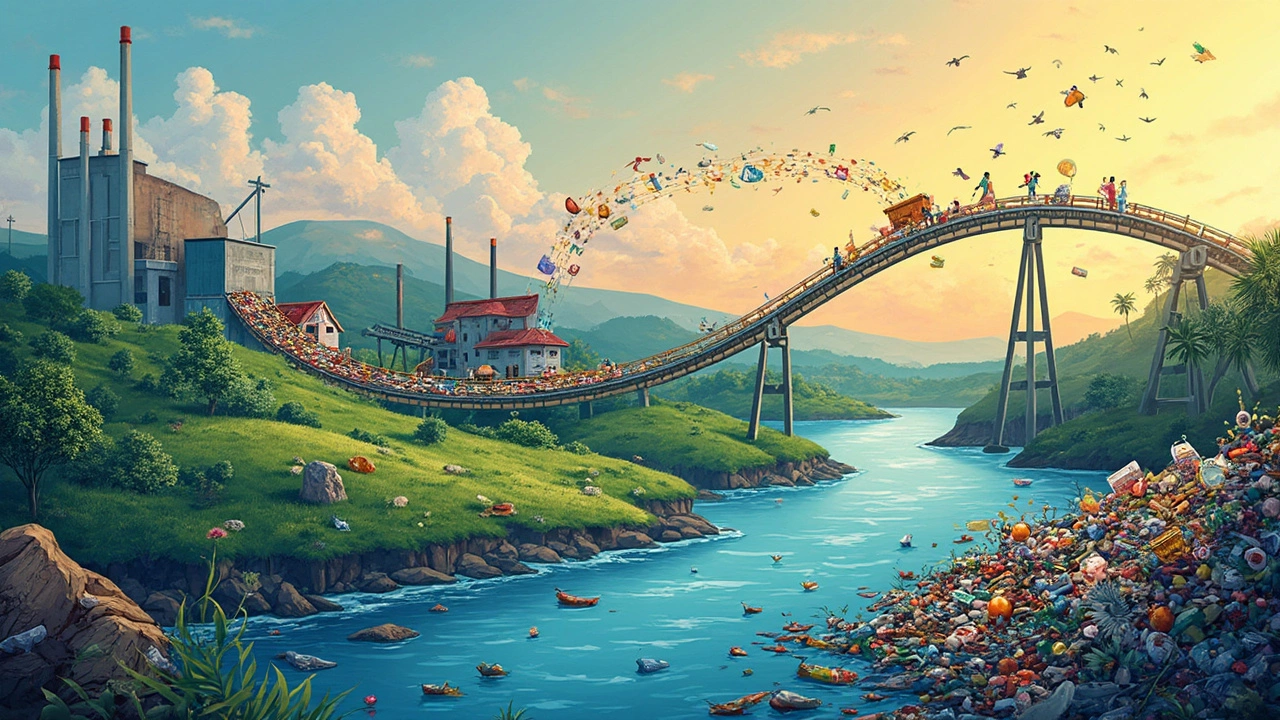
Ever wondered which single-use plastic rules the roost? It’s not just a random guess. The title belongs to plastic bags. Yep, those flimsy little things you get with every grocery run. They seem harmless, but they pile up big time. Think about how easy it is to forget to bring a reusable bag. Suddenly, you're knee-deep in a sea of plastic bags.
Plastic bags are pretty much everywhere. Why? They're lightweight, cheap, and oh-so-convenient. It doesn't take long to churn them out in factories, making them super popular. But who pays the price for all this convenience? The environment, big time. It takes over 500 years for these bags to decompose, and they never fully vanish, instead sticking around as microplastics.
- Understanding Single-Use Plastics
- The Biggest Offender Revealed
- Production and Popularity
- Environmental Consequences
- Industry Insights
- Steps Towards a Plastics-Free Future
Understanding Single-Use Plastics
Alright, so let’s break down what we're talking about when it comes to single-use plastics. These are things designed to be used once and then tossed away. You find them in everything from water bottles to takeout containers. Convenient? Absolutely. But here’s the kicker: they don’t just disappear. Instead, they sit around, cluttering our planet.
Why are these plastics so prevalent? It’s simple. They’re cheap to make and exceptionally practical. Imagine grabbing a coffee on the go. Without a second thought, you’ve added one more plastic cup to the pile. Manufacturers love them because they're a goldmine—they keep production costs low while meeting consumer demand for convenience.
How much is being produced? Tons! We're talking over 300 million tons of plastic every year, with a significant chunk being single-use. A scary part? Less than 10% of all plastic ever created has been recycled. So where does the rest go? Landfills, oceans, all the places they shouldn’t be.
The lower recycling rates mainly stem from how these products are constructed. They’re often made with a mix of materials that are tough to break down. Plus, the infrastructure to recycle is sometimes lacking. With millions of people using them every day, it’s no wonder they’re piling up.
Here's a snapshot of just how widespread the production is:
| Year | Global Plastic Production (Million Tons) |
|---|---|
| 2020 | 367 |
| 2021 | 381 |
| 2022 | 390 |
Seems overwhelming, right? It is, which is why understanding the scale and impact of these plastic waste giants is crucial. Knowing the ins and outs can set the stage for taking steps towards a more sustainable way of living.
The Biggest Offender Revealed
So, which single-use plastic holds the heavyweight title? Drumroll, please... it’s the ubiquitous plastic bag. These sneaky little bags seem harmless when you grab one to carry out your groceries, but they are the uncontested champions in terms of volume. Every year, an eye-popping 1 trillion plastic bags are produced worldwide. That’s like dishing out nearly 2 million bags per minute!
Plastic bags win the title because they're insanely easy and cheap to produce. Turning a bunch of ethylene gas into a bag is a quick manufacturing marvel. The process costs close to nothing compared to the toll they take on Mother Nature. A plastic bag's short lifecycle is a problem. Used for an average of 12 minutes, they fester for centuries. Talk about a bad trade-off!
Most plastic bags are made from polyethylene, a tough customer when it comes to breaking down. Ever wonder where they vanish to? The sad reality is many end up in oceans, contributing massively to marine pollution. Sea turtles like to munch on them, thinking they're jellyfish, which is a tragic mistake.
It's clear why these bags are leading the charge in environmental impact. Because of their lightweight build, they aren't just chilling in landfills. Nope, the wind loves them, which means they're more likely to become litter, making their way into trees, waterways, and eventually into the food chain as microplastics.
Production and Popularity
Plastic bags are a staple in the world of single-use plastic. They're made from a material called polyethylene, which starts its life as ethylene gas. The manufacturing process is like a high-speed race. Ethylene gas gets heated up and turned into liquid plastic. This stuff is stretched into thin sheets, cut, and sealed to make bags. And voilà, they’re ready for action.
What's fascinating is just how quickly and cheaply these plastic bags are churned out. A single machine spews out hundreds of bags every minute. Manufacturers love them because of their low production cost and high turnover rate. Imagine picking up a pack of chips. It's that easy for companies to produce these bags.
The popularity of these bags skyrocketed in the 1960s when they first hit the market. Before you knew it, they were a global hit. Their lightweight and durable nature made them attractive to both companies and consumers. Need to carry snacks, clothes, or books? There's a plastic bag for that.
However, being easy to produce and distribute doesn't come without a downside. Each year, about one trillion plastic bags are used around the world. That’s like nearly one million bags every minute. It's a bit overwhelming. The ease of convenience has made them a key player in plastic waste and its environmental impact.
For a clearer picture, check out this table showing the global production of plastic bags over recent years:
| Year | Worldwide Production (billion bags) |
|---|---|
| 2020 | 500 |
| 2022 | 800 |
| 2024 | 1000 |
The numbers don’t lie. These bags are here, they’re everywhere, and unless we start making changes, they’ll keep piling up. But being aware and mindful about our choices can guide us toward solutions.

Environmental Consequences
Alright, let’s talk about why these single-use plastics, especially plastic bags, are a headache for the planet. The big issue starts with how long these things linger. A plastic bag can outlive a human being by a few centuries. They just chill in landfills, slowly breaking into tiny pieces called microplastics, which are really tough to get rid of.
Now, imagine these microplastics getting sucked into waterways. That’s bad news for aquatic life. Sea turtles often mistake floating plastic bags for jellyfish, and animals getting tangled in debris happens way more than you'd think. It's pretty tragic.
Beyond just wildlife, plastic waste contributes to the bigger picture of pollution. Every year, over 300 million tons of plastic gets produced, with single-use items stealing the spotlight. It’s like dumping waste weighing as much as all humans combined into nature. Not exactly the kind of record we want to break.
Oh, and don’t forget about the whole climate change thing. The production of plastics involves a massive carbon footprint. When decomposing (slowly, but surely), these plastics also release greenhouse gases, pushing Earth a little closer to the brink.
Got any pro tips? Start with small steps, like skipping the bag at checkout if you’ve just got a couple of items. Every action counts, and imagine the big difference we could make if most folks just pitched in a bit.
Industry Insights
Diving into the plastic-making world reveals a mix of jaw-dropping efficiency and environmental conundrums. Plastic manufacturing companies have created an industry that operates at lightning speed to meet the never-ending demand for single-use plastics. Factories churn out millions of plastic bags in mere minutes, thanks to advances in extrusion technology and automation.
It's interesting to know that in terms of production, China leads the pack, cranking out nearly a third of the world's single-use plastics. The United States and multiple countries in Europe aren't far behind. However, the focus is slowly shifting, as governments and industry leaders realize the urgent need to curb plastic waste.
Major players in the plastic manufacturing game don't just focus on quantity; they're also investing in research and innovation. Giant companies like Dow and ExxonMobil Chemical are exploring eco-friendly alternatives. Biodegradable plastics and recycling enhancements are a hot topic, pressing forward with solutions that aim to lessen the burden on our planet.
Still, the road to change isn't an overnight journey. While new manufacturing technologies promise greener solutions, scaling them to replace traditional plastics across the board is a beastly challenge. Plus, transitioning systems and educating consumers about eco-options involves time, money, and a shift in mindset.
Being informed as consumers can make a tangible difference. Supporting brands that invest in sustainable practices and choosing eco-friendly options, whenever possible, adds up. With industry insight, we can each play a part in paving the path toward a plastics-free future.
Steps Towards a Plastics-Free Future
Feeling overwhelmed by the mountain of single-use plastics in your life? You're not alone. But the good news is, ditching these pesky plastics isn't rocket science—small steps can lead to big changes. Imagine a world where plastic waste doesn’t clog up our oceans and cities. Here's how we can get there together.
First off, it's all about reusables. Swap those plastic bags for cloth ones. Got a water bottle? Make it a sturdy metal or glass one instead of sipping from a plastic bottle every day. It’s not just trend-setting; it actually helps cut down on single-use plastic.
Next, think about refusing plastic. Asked if you'd like a straw? Say no thanks. It's a simple refusal that saves so much waste. And for those takeout meals, why not bring your own containers? Restaurants are getting on board with customers bringing their own options, so let's make it a movement.
- Refill instead of rebuying. Refill stations are popping up in many supermarkets for essentials like detergent and shampoo.
- Choose products with smarter packaging. Brands are catching on to the demand for sustainable packaging—seek them out!
- Support local bans. Many cities and countries have banned single-use plastics. Be an advocate in your community for similar changes.
Looking at the bigger picture, the plastic manufacturing industry is beginning to shift too. Innovations in biodegradable plastics offer hope. While it's still evolving, keeping an eye out for these materials can be a game-changer.
Here’s a quick glimpse of how countries are making strides in this space:
| Country | Policy Initiatives |
|---|---|
| France | Banned single-use plastic plates and cutlery |
| Kenya | Enforced one of the strictest plastic bag bans |
| India | Committed to eliminating single-use plastics by 2030 |
Embrace these steps with an optimistic mindset. A plasticky-free future might seem a world away, but our small actions today lead to massive improvements tomorrow. Let’s make a future that's cleaner, healthier, and free from the suffocating grip of plastic.